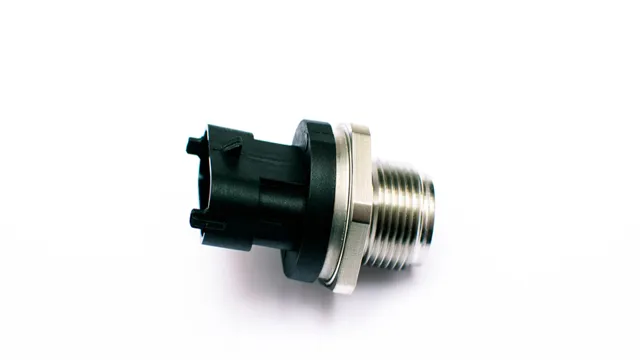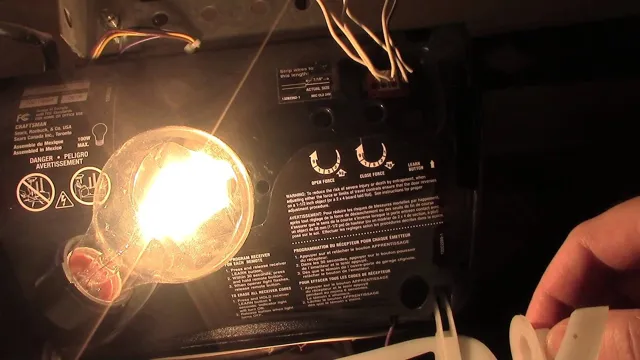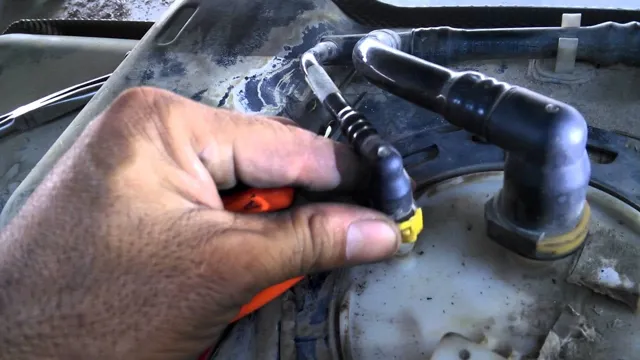Bypassing Fuel Temperature Sensor: A Quick Guide to Unlock Your Vehicle’s Full Potential.
Are you tired of dealing with a faulty fuel temperature sensor? It can be frustrating when your vehicle’s performance is being hindered by a malfunctioning sensor. The good news is that there are ways to bypass the fuel temperature sensor and get your vehicle running smoothly again. The fuel temperature sensor is responsible for providing data to the engine control module regarding the temperature of the fuel.
This information is used to adjust the fuel injection timing and provides optimal performance. If the temperature sensor is faulty, it can cause issues such as poor fuel economy, reduced horsepower, and even engine damage. By bypassing the fuel temperature sensor, you can eliminate these issues and get your car running the way it should.
There are a few methods for bypassing the sensor, including using a resistor to trick the ECU into thinking the fuel is at the correct temperature, or simply disconnecting the sensor altogether. However, it’s important to note that bypassing the sensor may lead to emissions or legality issues, so it’s important to consult an expert before making any modifications. Overall, bypassing the fuel temperature sensor can be a simple solution to a frustrating problem.
If you’re experiencing issues with your vehicle’s performance, it’s worth considering this option. However, make sure to weigh the potential consequences before making any modifications.
What is a Fuel Temperature Sensor?
A fuel temperature sensor is a device that measures the temperature of the fuel inside a vehicle’s fuel tank. It is an important component of the engine management system as it provides data to the engine control unit (ECU), which then adjusts the fuel injection timing and air-fuel mixture accordingly, depending on the fuel temperature. In some cases, a faulty fuel temperature sensor can cause a car to misfire, consume more fuel than usual, or even stall.
If you suspect that your fuel temperature sensor is faulty and are wondering how to bypass it, you should be aware that this is not recommended and can lead to potential problems. The bypassing of such a crucial component can cause adverse effects on the engine’s performance and efficiency, which could prohibit you from passing an emissions test. Instead, we recommend replacing it with a new one or seeking the advice of a professional mechanic to diagnose the underlying issue.
Overall, it is crucial to keep all engine components in good working condition to maintain optimal performance and fuel efficiency.
Explanation of Fuel Temperature Sensor’s Functionality
A fuel temperature sensor is essentially a device that monitors the temperature of the fuel in your vehicle’s fuel injection system. As the temperature of the fuel changes, so does its density, which in turn affects how it behaves within the system. The sensor relays this information to the engine control module, which can then adjust the amount of fuel delivered to the engine accordingly.
This helps to ensure optimal engine performance, as well as prevent engine damage or premature wear caused by fuel that is too hot or cold. Essentially, the fuel temperature sensor is an important component of your vehicle’s engine system that helps to optimize fuel delivery and ensure optimal performance. So, if you want to keep your vehicle running smoothly and efficiently, it’s important to make sure that your fuel temperature sensor is working properly.
Why Bypass the Fuel Temperature Sensor?
If you’re looking to bypass the fuel temperature sensor in your car, you may be wondering why it’s necessary. The fuel temperature sensor is responsible for measuring the temperature of the fuel in your car’s tank. This information is then transmitted to the engine control module, which adjusts the fuel supply accordingly.
However, if the sensor is damaged or malfunctioning, it can send incorrect temperature readings, causing the engine to run poorly. In some cases, the engine may not start at all. Bypassing the fuel temperature sensor can be a temporary solution to get your car running again.
However, it’s important to note that this should only be done as a last resort and can cause other issues down the line. If you do decide to bypass the sensor, it’s crucial to be aware of the potential risks and to consult with a professional mechanic beforehand.
Reasons for Bypassing the Sensor
If you want to improve the performance of your vehicle, bypassing the fuel temperature sensor can be a good option. The fuel temperature sensor is responsible for measuring the temperature of the fuel, which is then sent to the engine control module to adjust the fuel mixture. However, sometimes this sensor can provide inaccurate readings due to a faulty sensor or wiring issue.
In such cases, bypassing the sensor can give you more control over the fuel injection and improve efficiency. It can also help to avoid engine damage in extreme temperatures. However, it’s important to note that bypassing the fuel temperature sensor can void your warranty and may be illegal in some states.
So, make sure to do your research and consult with a professional before making any modifications to your vehicle.
Methods for Bypassing Fuel Temperature Sensor
If you’re experiencing issues with your fuel temperature sensor, you may be wondering how to bypass it. There are a few methods you can try, but it’s important to note that tampering with your vehicle’s sensors can have consequences. One option is to simply unplug the sensor, but this can trigger warning lights and reduce fuel efficiency.
Another approach is to install a resistor in place of the sensor, but this may not work for all vehicles and can also result in inaccurate readings. Some people also recommend using fuel additives to prevent fuel from getting too hot or cold. Ultimately, it’s best to consult a professional mechanic for advice and assistance in resolving any issues with your fuel temperature sensor.
Remember, safety and efficiency should always be a top priority when working with your vehicle.
Method 1: Install a Resistor
If you’re having issues with your fuel temperature sensor, there are ways to bypass it. One method is to install a resistor in the sensor’s wiring. A resistor is a passive electronic component that can reduce the flow of electrical current.
By adding a resistor to the sensor’s wiring, you can trick the system into thinking that the fuel temperature is within an acceptable range, even if it’s not. This method is simple and relatively cheap, but it’s important to note that it may not be the most effective solution. In some cases, the fuel temperature sensor may still be able to detect the actual temperature, which could cause performance issues.
If you’re considering this method, it’s best to consult with a mechanic or expert to ensure that it’s the right course of action for your specific situation.
Method 2: Remove the Sensor and Connect the Wires
When it comes to bypassing the fuel temperature sensor, there are a couple of methods you can try. One of these methods is to simply remove the sensor and connect the wires. This may seem like a simple solution, but it can be a bit more complicated than you might think.
First, locate the fuel temperature sensor in your vehicle. It’s typically located near the fuel rail or fuel tank. Remove the sensor from the vehicle, being careful not to damage any of the wires or connections.
Once you’ve removed the sensor, you’ll need to connect the wires that were attached to it. This can be tricky because you need to make sure you’re connecting the right wires. If you’re not sure which wires to connect, consult your vehicle’s wiring diagram or seek advice from a mechanic or experienced car enthusiast.
Once you’ve connected the wires, you should test your vehicle to make sure everything is working properly. While removing the fuel temperature sensor and connecting the wires can be an effective way to bypass it, you should keep in mind that this method can have some downsides. For one, your vehicle’s engine control module may still be expecting input from the sensor, which could cause issues with engine performance or efficiency.
Additionally, running your vehicle without a fuel temperature sensor could lead to inaccurate readings and potential damage to your engine, especially if you’re operating in extreme temperatures. Overall, while it’s possible to bypass the fuel temperature sensor using this method, it’s important to proceed with caution and consider the potential consequences. And if you’re not comfortable working on your vehicle’s electrical system, it’s always best to consult a professional.
Important Considerations When bypassing the Sensor
If you’re looking to bypass your fuel temperature sensor, there are some important considerations to keep in mind. First and foremost, you should be aware that tampering with your vehicle’s sensors can potentially cause damage and should be done with caution. Additionally, if you are bypassing the sensor to avoid a warning light or other issue, it’s important to address the underlying problem rather than simply disabling the sensor.
Another factor to consider is the potential impact on your vehicle’s emissions, as modern cars often rely on sensors to meet regulatory requirements. Finally, be sure to use reliable and reputable resources when researching how to bypass a sensor, as incorrect information can lead to serious problems down the road. Ultimately, before attempting to bypass a fuel temperature sensor, it’s best to consult with a qualified mechanic to ensure that you’re making a safe and informed decision.
Impact on Fuel Efficiency and Performance
When considering bypassing sensors in your car, it is important to keep in mind the impact it can have on both fuel efficiency and performance. While it may seem like a quick fix for certain issues, bypassing sensors can actually result in decreased fuel efficiency and potential damage to your engine. This is because sensors play a key role in regulating things like fuel flow and air intake to ensure optimal performance and efficiency.
By bypassing these sensors, you may inadvertently disrupt these important functions and cause your car to run less efficiently. Furthermore, tampering with sensors can also damage important components of your engine, compromising its overall performance. So before you bypass any sensors, it is important to weigh the potential risks and benefits and proceed with caution.
Possible Legal Implications
When thinking of bypassing sensors, it’s important to consider the legal implications. While it may seem harmless, tampering with sensors in certain industries or situations could be considered illegal. For example, if you bypassed a smoke detector in a rental property, you could be held liable for any damages or injuries that occur because of a fire.
Additionally, bypassing sensors in a car could potentially void a warranty or violate safety regulations. It’s crucial to fully understand the potential legal consequences before attempting to bypass a sensor. It’s always best to consult with a professional or do thorough research before making any modifications.
By doing so, you can ensure that you’re making an informed decision and avoiding any legal troubles down the road.
Conclusion
In conclusion, bypassing a fuel temperature sensor might sound like a good idea to some, but it’s important to remember that sensors exist for a reason. Sure, you might be able to trick your vehicle into running with cooler fuel, but it could come at the expense of efficiency or even cause damage to your engine. So instead of trying to outsmart the system, consider taking the old-fashioned approach of getting your sensor fixed or replaced if it’s causing issues.
After all, there’s nothing more clever than maintaining your vehicle properly and ensuring it runs smoothly for years to come.”
FAQs
Why would someone want to bypass the fuel temperature sensor?
Bypassing the fuel temperature sensor may be necessary when the sensor is faulty and causing incorrect readings, or when the sensor is not compatible with the aftermarket fuel system being used.
Is it legal to bypass the fuel temperature sensor?
Bypassing the fuel temperature sensor may be illegal in some areas as it can affect the emissions of the vehicle. It is important to check local regulations before attempting to bypass the sensor.
How can I bypass the fuel temperature sensor?
The method for bypassing the fuel temperature sensor will vary depending on the make and model of the vehicle. Generally, it involves manually wiring the fuel system to bypass the sensor or installing a resistor to trick the system into reading the correct temperature.
What are the risks of bypassing the fuel temperature sensor?
Bypassing the fuel temperature sensor can cause issues with fuel efficiency, emissions, and engine performance. It is important to ensure that bypassing the sensor is a necessary and safe solution before attempting to do so.







